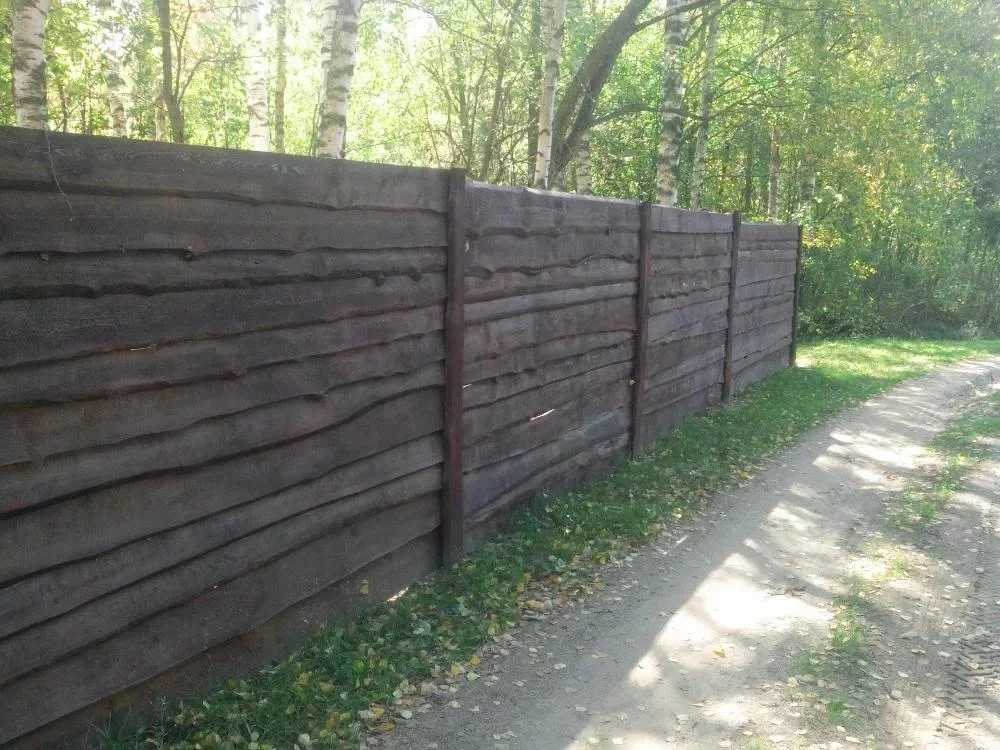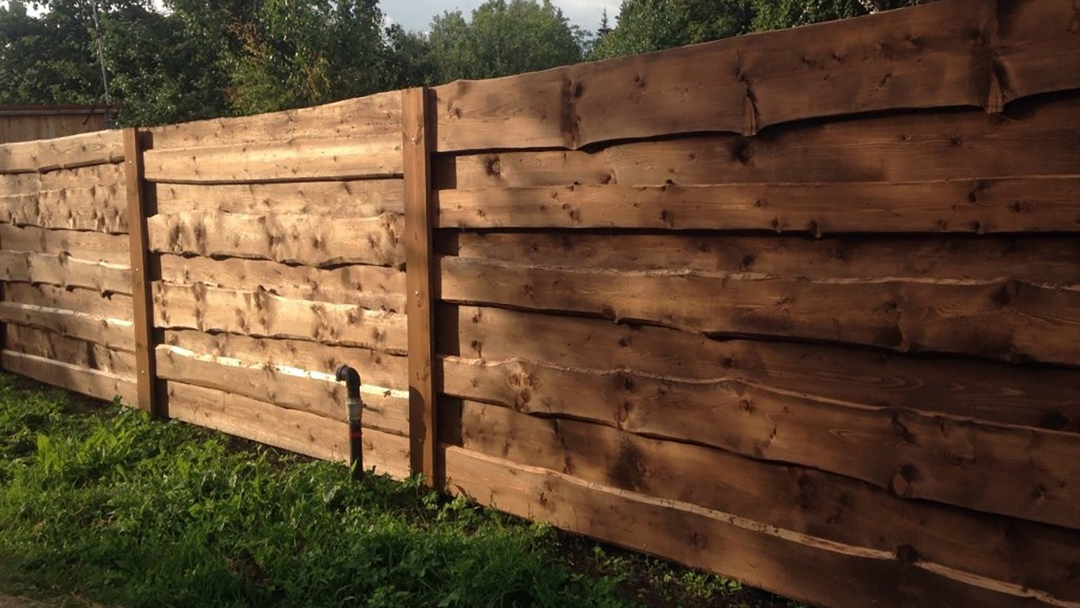To protect the private home of an object, its owners often build a fence made of boards. Natural, carefully crafted wood gives warmth and looks luxurious. Designs from untreated wood allow "put together" the fence in a matter of hours - the special skills it does not need.

Wooden fences among the owners of summer cottages are extremely popular.
Wood in the construction of fences: strengths and weaknesses
Content
- Wood in the construction of fences: strengths and weaknesses
- Types of fences: facade, decorative, simple
- Which boards are used for fencing installation
- Unedged board: definition, types
- Photo examples of suitable types of wood
- Selection of ideas, photos of fences made of boards
- conclusion
- VIDEO: Options beautiful wooden fences.
- 50 original design ideas of fences made of wood:
Natural wood, used in the construction of fences, has the following advantages:
- environmentally friendly product goes as entirely made of natural materials that do not harm the environment;
- this fence is easy to manufacture, easy to install their own hands, and the details can be given virtually any shape;
- polished, painted article has a beautiful appearance;
- it is possible to set the details as you like - horizontally, vertically, obliquely, in a staggered manner;
- acceptable use edging edging boards, beams, slabs, parts of various widths and lengths.
In the natural wood has its drawbacks:
- finished product is not very durable, since gradually decomposes under the action of sunlight and precipitation;
- to create a beautiful fence, wood is necessary not only to "dissolve" on the board, but also dried, sanded, cut parts;
- no special surface treatments, coatings, fence will not be durable;
- each crack, loose knot, increase the likelihood of breakdown details of construction and the bad drying leads to deformation.

True connoisseurs know that natural material - is always beautiful, environmentally friendly, modern and stylish.
Tip: To fence served as a long time (20-30 years), the details are impregnated with antiseptics, special paints, sun protection, flame retardants and others.
Types of fences: facade, decorative, simple
Protections are classified into three main types:
- Facade - designed to protect inland from prying eyes, unauthorized entry. This vertical truss structures or fence, "ranch" (horizontal skin), stair embodiments where the boards are arranged overlapping, chess, in which parts are mounted in two rows with offset, "stockade" created of sharpened stakes, as well as options, which are intertwined planochki solid rope;
- Decorative - usually serve only a decoration, arranged around the flower beds are a little high. Such fences are made of fine dosochek coated lime supplemented various ornaments
- The simplest - usually a fence consisting of logs or stakes driven into the ground, fastened in the middle or top of the boards. The design does not differ durability, used as a temporary fence
Which boards are used for fencing installation
When selecting material, paying attention to the thickness of the boards. The most suitable - 18-24 mm. Thicker usually cost more subtle - quickly break down.

In the presence of taste in the fence area of the owner of the tree may look expensive and really impressive.
Also used:
- Unedged board - gross product has uneven edges of the crust. Suitable for temporary restorations where aesthetics is not important. The material has a low cost, it is sold almost everywhere. It is permissible to use the facilities in a country style, rustic;
- Croaker - a type of edging boards. It has one convex and one flat side;
- Cutting board - the most popular option, suitable for all types of fences;
- Planed board - after further processing of edges passes through the marking gauge, jointer;
- Molded - strips of small thickness cut by means of the machine tool having protrusions, recesses at the ends, for easy connection to the supports and each other. Fence made of lining - it is a solid impenetrable fence you want to be treated periodically with protective compounds, to serve as long as possible;
- Curly trims - each of them has an unusual shape, decorated with carved ends also made curly. The finished construction is typically looks like fence;
- Artificially aged boards - are generated from the unedged board, through special processing;
- Patio or deck boards - are made of wood flour, modifying agents, polymers. Ready fence very durable, beautiful, original look. Sami details are made smooth or grooved;
- Brushed plaque - its topsheet "lifted" special brush. The construction has a unique texture - on the surface of visible growth rings.
Beautiful fence edged boards - the most popular protective structures. He is a solid, smooth or has holes, allowing the natural light. The product comes out much more expensive fence of slab or edging boards.

Fencing the estate - one of the most essential elements in the garden area, regardless of its size.
Fence of the boards from the horizontal stacking called "American". It is set on concrete pillars, to protect against rain canopy. The finished design looks very robust, impenetrable, it relates to an elite embodiment. Boards are dried in the factory for him - only selected high-quality wood. Such a fence is made of dry cladding boards mounted in a special section and overlap only horizontally. The design can not be viewed outside the site, which should be considered if the area is small and narrow. The average height of the building - 1.6-2.2 meters, but some owners of luxurious mansions built fences and three meters high.

Wood as a raw material is more expensive than corrugated sheet, but cheaper than brick or forged metal.
Unedged board: definition, types
Unedged board referred to neopilennymi, untreated or partially treated edges. They are much smaller than the other, but also reliable, durable, suitable for use in the streets, the harsh climate. Such materials are well handled, and the presence of knots and irregular grain is regarded as a decoration.

In favor of the choice of this material shows it is a property as environmental friendliness.
The main types of edging boards - a fence, and carpentry. For the first variant of multiple permissible, but not loose knots, changed in some places the direction of the fibers, small material damage. Second - this is a high quality raw materials, in which the minimum of defects, flaws. Battens manufactured therefrom and ready fence looks more attractive than built of fence boards.

There are special formulations to treat and protect the wooden fence wood from fungus or bugs.
For the production of uncut material, use the second or third cuts the tree trunk - low grade feed. The thickness of such plates - 25-50 mm, width -. 100-200 mm. or a little more. The main raw materials - pine, spruce (larch is not a cheap material). When buying any type of edging boards for building the fence, it is recommended to select one where smaller knots - in these parts for a long time more likely to maintain the correct geometry, avoiding deformation, cracking. When self-handling is unacceptable to use an excessively wet, nedosushennye boards - they warp during operation. Curved parts are also not suitable for a good fence.

You can cover structure lacquer, varnish or a special ink enriched safeners.
Fence edging board is suitable for mixed landscapes, as well as close to nature. He does not break the overall design of the site, but most are planted along this design curly ornamental plants.

Wood - a natural and eco-friendly material that does not pollute the environment.
Photo examples of suitable types of wood
To create a fence will suit almost any timber. This type of wood from the first to the fourth, wall paneling "American" et al. The photo shows that the best option - to choose a smooth, level board, devoid of knots, irregular grain, cracks, chips, traces of mold or damaged by pests.

wood fence will not require a lot of effort to care for him.
For the construction of the fence preferred coniferous or deciduous wood expensive - pine, spruce, larch, pine, beech, oak stained. If necessary, reduce the cost of construction, as well as, if its longevity is not priority, using the most common deciduous wood - birch, linden, ash, asp et al. Depending on what kind of fence is needed, use edging, planed, terraced or other species.

If you choose a solid rock, such as larch, oak or ash, it will extend the life of the fence.
Selection of ideas, photos of fences made of boards
Fence from a wide edging board looks very original, though rude. He toned stained artificially sostarivayut in some places. Facilities of Gorny boards sometimes painted or hand every detail is a different color.
Looks nice design, the upper edge of which resembles a "wave" or "pyramid". Quite original fence, consisting of pre-assembled modules as a "Christmas trees" and "suns", painted in the appropriate color, alternating with each other. Volumetric 3D-fence, decorated with floral patterns, usually surrounded by luxury homes, as are expensive. If there are children in the house, instead of individual pillars in the fence cut "wooden grandfathers" or "gnomes", which can also paint.

Natural material is in harmony with the environment.
conclusion
Options construction of wooden fence around a private residence, cottages, any business, there are many. They differ in the speed of construction, the level of the aesthetic appearance of the finished structure. The most relevant options fences are regularly published on the Internet, on sites related to construction and dacha farming.

Wooden fences are so different in appearance that in fact they are united by only one thing - the wood material from which they are made.



